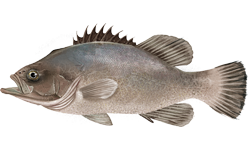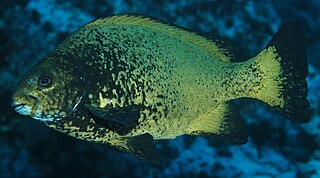
Congiopodidae, commonly known as pigfishes, horsefishes and racehorses, is a family of ray-finned fish classified with in the order Perciformes. These fishes are native to the Southern Hemisphere.

The wreckfish are a small group of ray-finned fish in the genus Polyprion, belonging to the monotypic family Polyprionidae in the order Acropomatiformes.

Trichogaster is a genus of gouramis native to South Asia from Pakistan to Myanmar. It is the only genus in the monotypic subfamily Trichogastrinae as set out in the 5th Edition of Fishes of the World, although that book states that there are two genera, the other being Colisa which is treated as a synonym of Trichogaster by Fishbase and the Catalog of Fishes. Fishbase also places the genus in the Luciocephalinae. Species of this genus are very popular in the aquarium trade.

The sea chubs, also known as rudderfish and pilot fish and in Hawaiian as enenue or nenue, are a family, Kyphosidae, of fishes in the order Perciformes native to the Atlantic, Indian and Pacific Oceans usually close to shore in marine waters.

Stichaeidae, the pricklebacks or shannies, are a family of marine ray-finned fishes in the suborder Zoarcoidei of the order Scorpaeniformes. Most species are found in the North Pacific Ocean with a few in the North Atlantic Ocean.
Remora is a genus of remoras native to temperate to tropical marine waters worldwide.

Conodon is a genus of grunts native to the Pacific and Atlantic coasts of the Americas. The currently recognized species in this genus are:

Heteromormyrus is a genus of freshwater ray-finned fishes belonging to the family Mormyridae, the elephantfishes. These fishes are found in southern and central Africa in Angola, Namibia, the Democratic Republic of the Congo and, maybe, Zimbabwe.
Chilorhinus is a small genus of marine ray-finned fishes belonging to the family Chlopsidae, the false morays. These eels occur in tropical waters
Neoconger is a genus of eels of marine ray-finned fishes belonging to the family Moringuidae, the spaghetti eels. These eels occur in shallow tropical and subtropical waters.
Congresox is a genus of marine ray-finned fishes belonging to the family Muraenesocidae, the pike congers. The fishes in this genus are found in the Indian and Pacific Oceans.

Cirrhimuraena is a genus of eels in the snake eel family Ophichthidae.
Kertomichthys is a monospecific genus of marine ray-finned fish belonging to the family Ophichthidae, the snake eels. The only member of this genus is Kertomichthys blastorhinos, a species known only from its holotype which was collected in the Atlantic Ocean in the vicinity of French Guiana.

Bangana is a genus of fish in the family Cyprinidae, the carps and minnows. It is distributed across much of southern and eastern Asia. Species live mainly in the flowing waters of tropical and subtropical rivers.

Pseudocaranx is a genus of ray-finned fishes from the family Carangidae, the jacks, trevallies, scads, and pompanos. They occur in the western Atlantic Ocean and the Indo-Pacific.
Paruroconger is a monospecific genus of marine ray-finned fish belonging to the subfamily Congrinae, the conger eels, in the family Congridae, which also includes the[[garden eel]s. The only species in the genus is Paruroconger drachi, an eel which is known only from the holotype collected in the Eastern Atlantic Ocean off Pointe-Noire in the Republic of Congo.

Macropodus is a genus of small to medium-sized labyrinth fish native to freshwater habitats in eastern Asia. Most species are restricted to southern China and Vietnam, but M. opercularis occurs as far north as the Yangtze basin, and M. ocellatus occurs north to the Amur River, as well as in Japan and Korea. In China, they are often used for fights, so they are named Chinese bettas because of their similarity to the genus Betta. A few species in the genus are regularly seen in the aquarium trade, and M. opercularis has been introduced to regions far outside its native range.

Pentaceros is a genus of marine ray-finned fish, armorheads from the family Pentacerotidae. They are native to the Pacific, Indian, and eastern Atlantic Oceans. Pentaceros is the only genus in the monotypic subfamily Pentacerotinae.

The ara, otherwise known as the saw-edged perch or the Dageumbari (다금바리) is a species of marine ray-finned fish from the monospecific genus Niphon in the monogeneric family Niphonidae. It is found in the Western Pacific Ocean from Japan south to the Philippines where it inhabits rock reefs and inshore waters with rocky sea beds. This species can grow up to 1 metre (3.3 ft) in total length. The ara was first formally described in 1828 by Georges Cuvier in the Histoire naturelle des poissons which he co-authored with Achille Valenciennes, the type locality was given as the Sea of Japan.

Spratelloididae is a small family of marine ray-finned fishes belonging to the suborder Clupeoidei of the order Clupeiformes, whih also includes the anchovies and herrings. The taxa in this family were previously classified within the family Clupeidae but are now considered to be a valid family. One genus, Jenkinsia is found in the Western Atlantic, the other, Spratelloides, in the Indian and Pacific Oceans.















